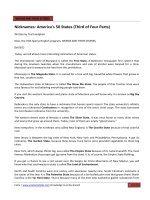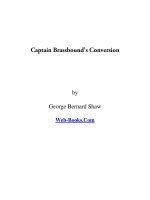Buddha's Tooth
Bạn đang xem bản rút gọn của tài liệu. Xem và tải ngay bản đầy đủ của tài liệu tại đây (481.54 KB, 18 trang )
Buddha’s Tooth
A Thailand Adventure
Robert A. Webster
2
Copyright © Robert A. Webster 2012
ISBN 978-1-4716-7140-1
The author or authors assert their moral right under the
Copyright, Designs and Patents Act, 1988, to be identified as
the author or authors of this work.
All Rights reserved. No part of this publication may be
reproduced, copied, stored in a retrieval system, or
transmitted, in any form or by any means, without the prior
written consent of the copyright holder, nor be otherwise
circulated in any form of binding or cover other than that in
which it is published and without a similar condition being
imposed on the subsequent purchaser.
.
www.buddhasauthor.com
3
-Foreword-
Some people are born to be heroes. Some people earn it
through years of trying. Allow me to introduce you to three
likely lads who had heroism strangely dropped on their heads.
Please enjoy the first adventures of Nicholas (Nick)
Godfrey, Stuart, (Stu) Wilson, and Peter Harris (Spock). Three
unattached, English, horny, mid thirty-year-old lads on holiday,
as they almost battle against evil forces, almost rescue damsels in
distress and almost save a country from total destruction.
They definitely do however, drink copious amounts of
amber fluid and have lots of horizontal fun. The story is set
mostly in the amazing city of Pattaya, located on the Eastern
Seaboard of Thailand. Lush green palm trees, crystal clear
waters, warm golden sand and herds of buffalo wandering
aimlessly over grassy meadows, you won’t find there. However,
chrome pole molesters, Go-Go dancers, ogling dens, cheap
amber fluid and beautiful, accommodating women more than
make up for it.
Follow their hilarious antics through the many stages of
intoxication; from ‘juiced’ through ‘spannered’ and ‘shitfaced’ up
to the ultimate stage of being totally ‘wankered’, as they
unknowingly enter into a chase between good and evil for the
recovery of an ancient holy relic. Enter into a diverse culture of
South East Asian people, whose attitudes, traditions, and lives,
have, and always will, remain a mystery to the Western world.
So, unless you like stories about buffaloes, please read on and
enjoy Siam Storm, an absolute must read survival guide for
anyone travelling to ‘The Land of Smiles’.
4
Korp khun krap
(Thank you)
Moreover, if you want something to do after reading this
epic. Think about this puzzle:
A man and women marry and have a baby boy. One year later, they
have another baby boy, but the two boys are not brothers. WHY?
If you are stumped, the answer is revealed in Chapter 21.
5
-Prologue-
The ancient stage is set. The delicate scent of jasmine, lotus
blossom and other oriental fragrances drifts soothingly through
the warm candlelit main hall of the Wat, the temple. Inside are
highly trained Chang, elephant warrior monks of the Tinju order,
kneeling with their foreheads touching the marble floor, arms
extended in front of them. They are deep in meditation and
await the moment, like crouching lions waiting for the scent of
their prey.
Situated in dense jungle and surrounded by jungle-encased
mountains, this Wat was said to be around 2000 years old and
built by monks in Salaburi, which was a remote village, just a
short distance away from the small south eastern
Thai/Cambodian border town of Pong-Nam-Rom. The Wat was
small by temple standards, with gleaming domes and arches,
covered in gold leaf and it had skilfully carved statues that
depicted Buddha’s journey through life, both as a prince and a
pauper.
The Wat was built against a mountain to the rear of the
village. The meticulously maintained Wat had a large door at the
front, a small door at the rear, and a door at the side leading to a
meditation room. The exterior of this small, windowless room,
had mosaic tiles formed into murals that depicted a nobleman
on a horse, smiling down upon a poor, decrepit individual. It
was believed this was the moment when Prince Siddhartha
Gautama decided to give up his earthly possessions and begin his
journey to enlightenment, eventually becoming known as
‘Buddha’ and entering Nirvana, heaven, whilst still alive.
6
Inside the meditation room was; an embalmed corpse laid
out on a stone slab, a foetus in a glass jar, preserved in a clear
liquid made from the bark of a local tree, and a skeleton. The
monks entered this room for intense meditation on the journey
through life and to reflect on birth, death, and the afterlife. Cut
into one wall was an entrance with a small tunnel, which led to a
large cave, and a heavy golden gate that covered the cave’s
mouth.
One hooded monk stood guard on either side of the gate. Each
carried a small bow and quiver filled with menacing arrows. The
handles of their sheathed swords sparkled, even through the dim
light. This cave housed the teachings of the Lord Buddha and
the Wat’s most valuable possession...four Pre-molars, wisdom
teeth of the Holy Buddha, kept in a golden box, about the size
of a matchbox and adorned with rubies and sapphires from the
nearby mines of Chantaburi.
The inner chamber of the main temple was basic, with large,
smooth marble pillars set on either side of a three-metre wide
aisle. Small mats were placed on the marble floor to the side of
the aisle for the monks to pray, receive teachings, and meditate.
Outside the main temple was the monk’s living quarters and
large arenas where they would learn fighting skills, both with and
without weapons. Although the weapons were ancient, in trained
Tinju hands they proved to be as deadly as any modern-day
weapon. Handed down from generation to generation, the
monks’ skills as great warriors, in all forms of combat were
legendary. The early kings of Siam, which has been known as
Thailand since 11 May 1949, used Tinju monks as bodyguards
and assassins throughout the centuries.
Due to inhospitable terrain, humidity, and many biting
insects, the approach to the village was difficult. With no roads
or visible tracks, the only people with the knowledge to find
their way were the villagers and monks. Through this anonymity,
the village and Wat remained unhindered for millennia. Using
7
knowledge passed down through the ages, they farmed the land,
tended their cattle, and survived on medicines provided by the
many trees and plants found in the surrounding forest. They
were totally self-sufficient and had no need for the trappings or
indulgences of the outside world that had long since forgotten
them.
The monks, all males, were chosen before birth. When a
Tinju monk died, the next first-born son of a villager became his
replacement. It was believed that he was the reincarnation of the
deceased Tinju. At just one day old, the infant was taken to the
temple. There he would remain for the rest of his life, never
knowing his real parents or family. The infant would be taken
care of, taught, and nurtured by the other monks. For the boy’s
family it was a great honour to have a son who was Tinju
because they were known for their great wisdom and kindness in
their search for enlightenment. They were born Tinju and died
Tinju.
There were currently 75 monks. The youngest was two years
old, and the eldest was 86. For the monks of the Tinju order, it
was their credo to guard the sacred relic. Active duty started at
the age of ten, and continued throughout their lives until they
were around 70 years old. They retired from active service and,
except for the ‘Prime Master’, lived the reminder of their lives as
elder monks, undertaking teaching and guidance for the young
monks.
A Siamese trader and emissary to the King, acquired the
holy remnants of Prince Siddharthra Gautama over 500 years
after his death, about the same time Christ was born. At the
time, it was widely believed that any ruler who worshipped the
relics of Buddha would be given the power to command and
rule wisely. The trader brought the relics to Siam from China
after searching for 20 years, but he was well rewarded for his
endeavour. They were presented to King Bumnalonkorn of Siam









